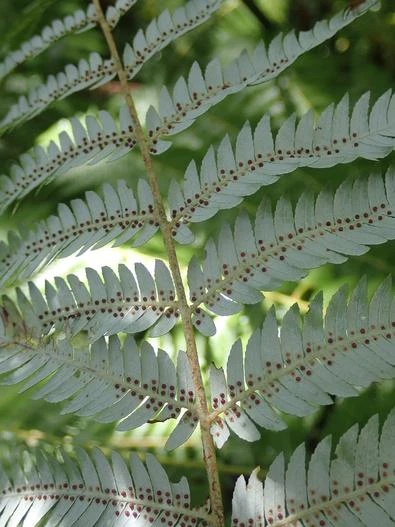Silver Fern
(Alsophila dealbata)
Silver Fern (Alsophila dealbata)
/
/

Margaret Donald
CC BY-SA 2.0
Image By:
Margaret Donald
Recorded By:
Copyright:
CC BY-SA 2.0
Copyright Notice:
Photo by: Margaret Donald | License Type: CC BY-SA 2.0 | License URL: https://creativecommons.org/licenses/by-sa/2.0/ | Uploader: MargaretDonald | Publisher: Flickr



Estimated Native Range
Climate Requirements for Buenos Aires, Argentina
| This Plant | Your Site | Plant Suitability for Your Location | ||
|---|---|---|---|---|
| • Precipitation | 18" - 192" | 45" | Aquatic | Aquatic |
| • High Temp. | 60°F - 87°F | 85°F | Your summer temperatures are normal for this plant. | Excellent |
| • Low Temp. | 23°F - 56°F | 44°F | Your winter temperatures are normal for this plant | Excellent |
This plant should grow well at your location with about N inches per year (Y minutes per month) of irrigation.
Summary
Alsophila dealbata, synonym Cyathea dealbata, commonly known as the silver fern or silver tree-fern, is a tree fern endemic to New Zealand, where it is a key component of the understory in temperate rainforests and cloud forests. It can grow up to 33 feet tall with a trunk up to 3 feet in diameter, and it features fronds that are roughly 13 feet long. The silver fern is easily recognized by the silver-white color on the undersides of its fronds, which contrast with the dark green upper surface. The plant’s appearance is striking, with its large, arching fronds creating a distinctive and graceful silhouette. Flowering is not applicable to ferns, but the silver fern’s fronds are highly ornamental and provide a lush, exotic look.
The silver fern is valued for its unique aesthetic and is often used in shaded garden areas, as a focal point in ferneries, or in large containers. It requires consistently moist, well-drained soil rich in organic matter and thrives in part shade to full shade conditions. While it prefers high humidity, it is somewhat adaptable to drier conditions if kept well-watered. The silver fern is relatively low maintenance but may need protection from strong winds and frost in colder climates. It is not known for significant disease or pest issues, but it can be sensitive to overwatering and root rot if drainage is poor. In cultivation outside its native range, care should be taken to prevent it from becoming invasive, as it can spread if conditions are favorable.CC BY-SA 4.0
The silver fern is valued for its unique aesthetic and is often used in shaded garden areas, as a focal point in ferneries, or in large containers. It requires consistently moist, well-drained soil rich in organic matter and thrives in part shade to full shade conditions. While it prefers high humidity, it is somewhat adaptable to drier conditions if kept well-watered. The silver fern is relatively low maintenance but may need protection from strong winds and frost in colder climates. It is not known for significant disease or pest issues, but it can be sensitive to overwatering and root rot if drainage is poor. In cultivation outside its native range, care should be taken to prevent it from becoming invasive, as it can spread if conditions are favorable.CC BY-SA 4.0
Plant Description
- Plant Type: Tree, Fern
- Height: 15-30 feet
- Width: 6-12 feet
- Growth Rate: Moderate
- Flower Color: N/A
- Flowering Season: Non-Flowering
- Leaf Retention: Evergreen
Growth Requirements
- Sun: Part Shade
- Water: Medium
- Drainage: Medium, Fast
Common Uses
Border Plant, Potted Plant
Natural Habitat
Temperate rainforests and cloud forests in New Zealand
Other Names
Common Names: New Zealand Tree Fern, Ponga
Scientific Names: Alsophila dealbata, Alsophila dealbata var. tricolor, Alsophila tricolor, Cyathea dealbata, Cyathea falciloba, Cyathea tricolor, Hemitelia falciloba, Polypodium dealbatum
GBIF Accepted Name: Alsophila dealbata